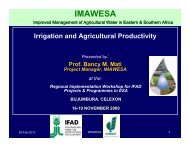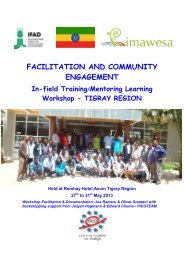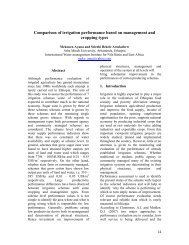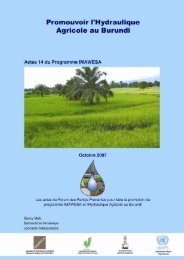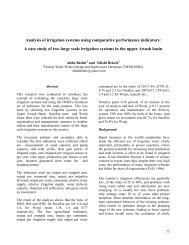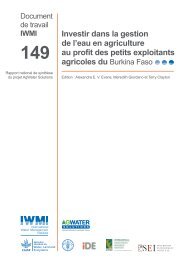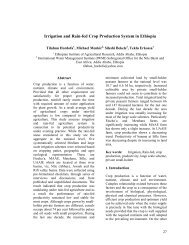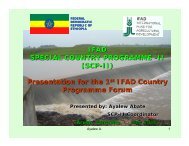sharing experiences among water user association in spate irrigated ...
sharing experiences among water user association in spate irrigated ...
sharing experiences among water user association in spate irrigated ...
Create successful ePaper yourself
Turn your PDF publications into a flip-book with our unique Google optimized e-Paper software.
M<strong>in</strong>istry of Water Resources and ElectricityHydraulics Research CentreSHARING EXPERIENCES AMONG WATER USERASSOCIATION IN SPATE IRRIGATED SCHEMESREGIONAL WORKSHOP REPORTPREPARED BY:EIMAN M. FADUL BASHIR, COORDINATOR SUDAN SPATE IRRIGATION NETWORK ( SSPN)ELTIGANI E. BASHIR, ASSISTANT PROFESSOR, UNIVERSITY OF GEZIRAAGEEL I. BUSHARA, ASSISTANT PROFESSOR, HYDRAULIC RESEARCH CENTREABRAHAM M. HAILE, CO-CHAIR INTERNATIONAL SPATE IRRIGATION NETWORK (SPN)December 2012Kassala-Sudan
SHARING EXPERIENCES AMONG WATER USERASSOCIATION IN SPATE IRRIGATED SCHEMESREGIONAL WORKSHOP REPORTPREPARED BY:EIMAN M. FADUL BASHIR, COORDINATOR SUDAN SPATE IRRIGATION NETWORK ( SSPN)ELTIGANI E. BASHIR, ASSISTANT PROFESSOR, UNIVERSITY OF GEZIRAAGEEL I. BUSHARA, ASSISTANT PROFESSOR, HYDRAULIC RESEARCH CENTREABRAHAM M. HAILE, CO C HAIR INTERNATIONAL SPATE IRRIGATION NETWORK (SPN)December 2012KassalaSudan
Table of ContentsTable of Contents................................................................................................................................1Executive summary .............................................................................................................................21. Introduction ................................................................................................................................42. Scope and objectives ...................................................................................................................43. Experience shared and lessons learned .......................................................................................53.1 Formation of WUAs, organizational structure and leadership ..............................................53.1.1 GAS Experience ............................................................................................................53.1.2 Yemen Experience .......................................................................................................63.1.3 Ethiopia Experience .....................................................................................................83.1.4 Khor Abu Habil Experience ...........................................................................................93.1.5 Toker Experience ....................................................................................................... 103.2 Water <strong>shar<strong>in</strong>g</strong>, conflict and conflict resolution ................................................................... 103.2.1 GAS Experience .......................................................................................................... 103.2.2 Ethiopian Experience ................................................................................................. 113.2.3 Yemeni Experience..................................................................................................... 113.2.4 Khor Abu Habil Experience ......................................................................................... 123.2.5 Toker Experience ....................................................................................................... 133.3 Operation and ma<strong>in</strong>tenance .............................................................................................. 133.3.1 Gash experience ........................................................................................................ 133.3.2 Khor Abu Habil Experience ......................................................................................... 153.3.3 Ethiopia Experience ................................................................................................... 163.3.4 Yemen Experience ..................................................................................................... 163.3.5 Toker Experience ....................................................................................................... 174 Conclusions and recommendations ........................................................................................... 175 Followup activities ................................................................................................................... 18
AcknowledgementsThe Hydraulics Research Centre (HRCSudan), of the M<strong>in</strong>istry of Water Resources and Electricity,would like to thank all those who contributed to the success of this workshop, <strong>in</strong> particular:The Government of Kassala State, the State Governor and the commissioner of North Delta. The Supreme Council of Water Users Associaons <strong>in</strong> Gash. The parliament of Kassala State. The Gash Agricultural Scheme, and the DG of the Scheme. The WUAs of Yemen, Ethiopia, Toker and Khor Abu Habil. IMAWESA, UNESCOIHE, Gezira University, IFAD. All farmers and technical staff who aended the workshop.
1. IntroductionThis document reports on the Regional Knowledge and Experience Shar<strong>in</strong>g Workshop that broughttogether fifty farmers and Water User Association (WUA) leaders manag<strong>in</strong>g <strong>spate</strong> irrigation systems<strong>in</strong> Wadi Zabid, Yemen; Guguf, Ethiopia and Gash, Toker and Khor Abu Habil, Sudan. In attendancewere also about 20 <strong>water</strong> professionals <strong>in</strong>clud<strong>in</strong>g the Directors of Gash and Toker Delta AgriculturalSchemes <strong>in</strong> Sudan (government <strong>in</strong>stitutions responsible for the overall management of irrigationschemes); coord<strong>in</strong>ators of the Participatory Small Scale Irrigation Development Projects (PASSIDP) <strong>in</strong>Tigray and Amhara Region, Ethiopia and the <strong>spate</strong> irrigation project team from Sudan, Yemen,Ethiopia and UNESCOIHE. The workshop was held <strong>in</strong> the period 15 18 December, 2012 <strong>in</strong> Kassala,Sudan.Spate irrigation is a type of <strong>water</strong> management that is unique to semiarid environments. It is found<strong>in</strong> the Middle East, North Africa, West Asia, East Africa and parts of Lat<strong>in</strong> America. Flood <strong>water</strong> frommounta<strong>in</strong> catchments is diverted from river beds (wadis) and spread over large areas. It is often thepoorest segments of the rural population whose livelihood and food security depends on the <strong>spate</strong>flows.The four day workshop that <strong>in</strong>cluded a fullday field visit to the Gash Agricultural Scheme <strong>in</strong> Kassala,Sudan; addressed the follow<strong>in</strong>g issues:1. Establish<strong>in</strong>g WUAs – why and how; organizational structure of WUAs; the leadership issuesfocus<strong>in</strong>g on appo<strong>in</strong>tment duration and <strong>in</strong>centives, successes and failures <strong>in</strong> manag<strong>in</strong>g theWUA and implement<strong>in</strong>g its ma<strong>in</strong> tasks.2. Water <strong>shar<strong>in</strong>g</strong>, conflicts and conflict resolution: rules and regulations, enforcementmechanisms.3. Operation and ma<strong>in</strong>tenance: plann<strong>in</strong>g, mobiliz<strong>in</strong>g resources, fund rais<strong>in</strong>g, cooperation withother (non) government organizations.The Spate Irrigation Network (SpN) (www.<strong>spate</strong>irrigation.org) has f<strong>in</strong>ancially cofunded theworkshop from its IFAD funded project. Substantial supplementary fund<strong>in</strong>g was provided byIMAWESA, the Improved Management of Agricultural Water <strong>in</strong> Eastern and Southern Africa(www.imawesa.net). The central aim of the workshop creat<strong>in</strong>g a platform for <strong>shar<strong>in</strong>g</strong> of knowledgeand best practices <strong>in</strong> management of agricultural <strong>water</strong> is very much ak<strong>in</strong> to the shared goals ofboth SpN and IMAWESA.The workshop was organized by the Apex Gash WUA, the Sudan Spate Irrigation Network (SSpN) andthe Hydraulic Research Centre (HRC) of the M<strong>in</strong>istry of Water Resources and Electricity. The Directorand eng<strong>in</strong>eers of the Gash Agricultural Scheme (GAS), the Gash WUA registrar <strong>in</strong> Kassala and GeziraUniversity, WadMedani have made valuable contributions to the organization of the workshop.2. Scope and objectivesThe workshop was of a regional scope draw<strong>in</strong>g on practical <strong>experiences</strong> of farmers and WUA leadersfrom Sudan, Yemen and Ethiopia. It addressed organizational, operation and ma<strong>in</strong>tenance and <strong>water</strong><strong>shar<strong>in</strong>g</strong> and conflict resolution aspects as practiced by the <strong>spate</strong> system farmers.
The workshop had two ma<strong>in</strong> objectives: Create a regional plat form for knowledge and experience <strong>shar<strong>in</strong>g</strong> <strong>among</strong> farmers and WUAsstriv<strong>in</strong>g to make beneficial use of floods through proper management of <strong>spate</strong> irrigationsystems. Document and dissem<strong>in</strong>ate the ma<strong>in</strong> <strong>experiences</strong> and good practices shared <strong>in</strong> the form ofpractical notes, videos and photos.3. Experience shared and lessons learnedThis section details the major <strong>experiences</strong> shared and the lessons learned by the farmers and WUAsthat represented the three countries (Sudan, Ethiopia and Yemen) <strong>in</strong> the workshop. The <strong>experiences</strong>are organized <strong>in</strong> three ma<strong>in</strong> topics: (i) Formation of WUAs, organizational structure and leadership;(ii) <strong>water</strong> <strong>shar<strong>in</strong>g</strong>, conflicts and conflict resolution; (iii) operation and ma<strong>in</strong>tenance.3.1 Formation of WUAs, organizational structure and leadership3.1.1 The GAS ExperienceStrengthLimitationsA strong <strong>in</strong>stitutional support before, dur<strong>in</strong>g and after the formation stage of WUAs hascontributed to several positive outcomes:o 92 WUAs have been established represent<strong>in</strong>g the five blocks at GAS: Kassala, Mekali,Tendali, Metateb, Dega<strong>in</strong> and Hadalya. An Apex WUA with two representatives fromeach block was also formed to serve as a coord<strong>in</strong>at<strong>in</strong>g unit.o Farmers’ names and records of tenancy have become known and fixed.o Bylaws approved by the Kassala State Council the Bylaws def<strong>in</strong>e the roles, tasksand rights and responsibilities of WUAs and their members.o Establishment of a WUA unit with<strong>in</strong> the GAS and the appo<strong>in</strong>tment of a WUAcoord<strong>in</strong>atoro WUAs are <strong>in</strong>creas<strong>in</strong>gly becom<strong>in</strong>g aware of their roles and responsibilities under thelaw that governs their status.1. Large number of farmers <strong>in</strong> one misga (300 to 600 farmers) that represents the smallest unitof a WUA. This created difficulty <strong>in</strong> management and timely decisionmak<strong>in</strong>g. Misga refers toa secondary canal that supplies <strong>spate</strong> flow directly to an <strong>irrigated</strong> command area, whichranges <strong>in</strong> size from 450 to 900 ha.2. Short (2 years) term of WUA leadership is <strong>in</strong>sufficient for properly plann<strong>in</strong>g, implement<strong>in</strong>gand evaluat<strong>in</strong>g largescale programmes.3. Lack of proper annual evaluation of the performance of the WUA leadership.4. Limited mandate the WUA is not active <strong>in</strong> other imperative issues, beside manag<strong>in</strong>g <strong>water</strong>,such as market<strong>in</strong>g, cropp<strong>in</strong>g pattern
Lessons learned and action po<strong>in</strong>ts consideredThe GAS WUA leaders s<strong>in</strong>gled out the follow<strong>in</strong>g <strong>experiences</strong> of the other WUAs as important andworthy for consideration:1. Extend<strong>in</strong>g the WUA election period from two to three years. Ethiopian Experience2. Group market<strong>in</strong>g for crops that protects <strong>in</strong>dividual farmers from sell<strong>in</strong>g their products at alow prices. This is <strong>in</strong> particular crucial for empowerment of poor farmers. Khor Abu HabilExperience.3. Includ<strong>in</strong>g women farmers as active members as well <strong>in</strong> leadership positions this proved tobe useful for better operation and ma<strong>in</strong>tenance, enforcement of Bylaws and overallmanagement of the respective <strong>spate</strong> irrigation scheme Ethiopia & khor abu HabilExperience.4. Incentive system for WUA leaders: either <strong>in</strong> k<strong>in</strong>d (irrigation priority) or <strong>in</strong> the form of bonusesor regular small payments. In Ethiopia, the <strong>water</strong> masters, the WUA leaders responsible foroversee<strong>in</strong>g <strong>water</strong> <strong>shar<strong>in</strong>g</strong>, have absolute right to irrigate their fields first. This highlymotivates the <strong>water</strong> masters to work diligently.3.1.2 Yemen ExperienceStrength1. Well def<strong>in</strong>ed steps for formation of WUAs:o Step 1: Preparation of extensive data base of farmers: personal details, farm<strong>in</strong>g<strong>experiences</strong>, size and location of irrigation fields, the type and sequences ofcrops grown.o Step 2: awareness creaon: extensive meengs and discussions focus<strong>in</strong>g onbenefits and responsibilities of be<strong>in</strong>g organized <strong>in</strong>to a WUA.o Step 3: discussion followed by decision on the best organizational structure anda set of leadership qualities required at different positions.o Step 4: Discuss<strong>in</strong>g and agree<strong>in</strong>g on <strong>water</strong> <strong>shar<strong>in</strong>g</strong> rules and regulaons, <strong>water</strong> feeand payment modalities, membership criteria and related matters.o Step 5: Prepar<strong>in</strong>g a WUA work<strong>in</strong>g document (bylaws) that encompasses thema<strong>in</strong> outputs of steps 1 to 4.o Step 6: tra<strong>in</strong><strong>in</strong>g on “manag<strong>in</strong>g WUAs” organiz<strong>in</strong>g meet<strong>in</strong>g, book keep<strong>in</strong>g,plann<strong>in</strong>g operation and ma<strong>in</strong>tenance and related work plans, enforc<strong>in</strong>g rules andregulations, mitigat<strong>in</strong>g and solv<strong>in</strong>g conflicts.o Step 7: Strategies for f<strong>in</strong>ancial susta<strong>in</strong>ability: develop<strong>in</strong>g capacity to becompetitive irrigation service providers to other government and private<strong>in</strong>stitutions thus generat<strong>in</strong>g <strong>in</strong>come, establish<strong>in</strong>g and ma<strong>in</strong>ta<strong>in</strong><strong>in</strong>g contacts withfund<strong>in</strong>g organizations (<strong>in</strong>ternal and external) as well as wealthy members of thecommunity resid<strong>in</strong>g <strong>in</strong>side and outside the country.Of the 38 WUAs <strong>in</strong> Wadi Mawr <strong>spate</strong> irrigaon scheme <strong>in</strong> Yemen, only 10 followed the above stepswith dedication and these have ended up be<strong>in</strong>g very successful:
Built f<strong>in</strong>ancial capital primarily by tapp<strong>in</strong>g <strong>in</strong>to the wealthy members of the community. Theyhave been able to collect 20,000 to 50,000 Yemeni Riyal (100 to 250 USD) each year from as<strong>in</strong>gle rich person they have a database rang<strong>in</strong>g from 50 to 200 persons. Established good relationship with the Tihama Development Authority (TDA), thegovernment organization responsible for the overall management of <strong>spate</strong> irrigation systems<strong>in</strong> Yemen and the Irrigation Council (IC), the government body tasked with coord<strong>in</strong>at<strong>in</strong>gactivities of all WUAs, and several other organizaons (Figure 1). Some of the benefits fromthe str<strong>in</strong>g relations with the TDA and IC are:o 50% reducon <strong>in</strong> mach<strong>in</strong>ery rent cost from the Irrigation Councilo Match<strong>in</strong>g funds for operation and ma<strong>in</strong>tenance from the TDA and IrrigationCouncil.o Less bureaucratic hurdles to withdraw<strong>in</strong>g and deposit<strong>in</strong>g money <strong>in</strong> their<strong>in</strong>dividual bank accountsFigure 1: Organizational network of Wadi Zabid Water User Associations, Yemen2. Full legal recognition of WUAs by the local government, facilitated the follow<strong>in</strong>g:o Each WUA has a bank account with the condition of three signatures for accountmanagement; the chair person, executive director and f<strong>in</strong>ancial manger.o Each WUA member has an identity card (ID card).Limitations1. The leadership has no power to decide on cropp<strong>in</strong>g pattern. The consequence has beenextensive banana plantation <strong>in</strong> the upstream, which has <strong>in</strong> turn deprived downstream areasof <strong>spate</strong> flow.
2. The lack of mandate of the WUA to control the digg<strong>in</strong>g of wells and manage over abstractionof ground<strong>water</strong> the ground<strong>water</strong> level has been and is sll decreas<strong>in</strong>g at alarm<strong>in</strong>g rate of 1to 1.5 m per year.3. Three of the 16 WUAs are big with 500 farmers as members of the smallest unit this createddifficulty <strong>in</strong> management <strong>in</strong>clud<strong>in</strong>g hold<strong>in</strong>g meet<strong>in</strong>gs, controll<strong>in</strong>g the <strong>water</strong> <strong>shar<strong>in</strong>g</strong>, properfee collection and organiz<strong>in</strong>g O& M activities.4. Limited coord<strong>in</strong>ation between upstream and downstream farmers along the ma<strong>in</strong> riversystem.Lessons learned and action po<strong>in</strong>ts consideredThe ma<strong>in</strong> lessons considered useful by the Yemen WUA representatives were the follow<strong>in</strong>g:1. Reduc<strong>in</strong>g the term of WUA leadership from 4 to 3 years and <strong>in</strong>troduc<strong>in</strong>g a mechanism forannual performance evaluation (Ethiopia experience).2. Provid<strong>in</strong>g well def<strong>in</strong>ed and officially agreed upon <strong>in</strong>centives for the leadership (EthiopiaExperience).3.1.3 Ethiopia ExperienceStrength1. Well def<strong>in</strong>ed and thorough WUA formation process that <strong>in</strong>cludes all, but step 7 stated <strong>in</strong> thecase of Yemen.2. A strong and effective executive committee that consists of five members: Chairperson,Secretary, Treasury and two Auditors elected with an open vote by the general assembly:3. Regularly meets on a biweekly basis to discuss irrigation and farm<strong>in</strong>g related issues.4. Annual meet<strong>in</strong>g with the general assembly to assess progress and agree on a work plan forthe year ahead.5. A woman representative is always <strong>in</strong>cluded <strong>in</strong> the leadership. For <strong>in</strong>stance, the secretary <strong>in</strong>the current executive committee is a woman.6. A streaml<strong>in</strong>ed organizaonal structure with manageable (30 to 50 farmers) <strong>in</strong> te smallestadm<strong>in</strong>istrave unit (Figure 2)General Assembly (800 <strong>spate</strong> irrigators)5 member execuve commiee: Chairperson,Secretary, Treasury, 2 auditors6 groups formed along a ma<strong>in</strong> canal, each led by a <strong>water</strong>master. One group consists of 100 to 150 members16 subgroups formed along one or more branch canals, each led by subgroupleader. A subgroup consists of 30 to 50 farmers
Figure 2: Organizaonal structure of Guguf Water User Associaon, Raya Valley, Tigray, Ethiopia,7. The leadership is granted by the General Assembly an absolute priority to irrigate their fieldsfirst. This <strong>in</strong>centive is <strong>in</strong>strumental for the dedicated and committed service provided by theexecutive committee, <strong>water</strong> masters and subgroup leaders.8. Good work<strong>in</strong>g relationship with the government agricultural extension service the latter hasprovided advice on use of fertilizers and crop varieties.Limitations1. The WUA leadership have weak relationship with the external nongovernment fund<strong>in</strong>g anddevelopment agencies.2. Absence of an umbrella farmers' organization that deals with the issues that concern two ormore WUAs at ma<strong>in</strong> river system.Lessons learned and action po<strong>in</strong>ts considered1. L<strong>in</strong>k<strong>in</strong>g the WUAs to development and fund<strong>in</strong>g organization to be <strong>in</strong>cluded to the mandate ofthe leadership (experience from Yemen).2. Establish a river system committee to deal with <strong>in</strong>terWUA issues (experience from GAS).3.1.4 Khor Abu Habil ExperienceStrength1. The WUA are well connected to various relevant organizations <strong>in</strong>clud<strong>in</strong>g the agriculturalscheme council, m<strong>in</strong>istry of agriculture, m<strong>in</strong>istry of f<strong>in</strong>ance, state executive managers, legal,private companies for seeds and for cotton market<strong>in</strong>g, agricultural research cooperation.2. Women farmers are well presented <strong>in</strong> the WUA management council.3. The WUA takes central role <strong>in</strong> protect<strong>in</strong>g farmers from sell<strong>in</strong>g of farm products at belowmarket prices.Limitations1. The WUA formation was not done on the basis of a thorough process as outl<strong>in</strong>ed <strong>in</strong> the caseof Yemen <strong>in</strong> the above discussions on steps 2 and 3 were <strong>in</strong>sufficient, while the other stepswere barely implemented.2. The WUAs do not have their own Bylaws. They operate under the regulations and rules ofthe other exist<strong>in</strong>g government cooperatives (e.g, Rules of Cooperative council). One of thenegative consequences is that the WUAs are not free to choose their own cropp<strong>in</strong>g pattern.3. There are two bodies claim<strong>in</strong>g entitlement to represent<strong>in</strong>g the farmers the labour unionsand the newly formulated WUA. There is power struggle <strong>among</strong> these two bodies as there isnot yet clear boundary of responsibilities.Lessons learned and action po<strong>in</strong>ts consideredThe Khor Abu Habil WUA leaders and farmers s<strong>in</strong>gled the follow<strong>in</strong>g for immediate consideration:1. Relaunch extensive consultations with the WUAs members to further strengthen theirunderstand<strong>in</strong>g on responsibilities and benefits of be<strong>in</strong>g organized <strong>in</strong>to WUA and the bestalternatives followed by other WUAs to ensure f<strong>in</strong>ancial and legal autonomy. Experiencesfrom Yemen and GAS.
2. To work for more legal framework for WUA organizational set up. GAS Experience3. Formulate bylaws for each of the WUAs that will guide the activities and decisions to betaken with regard to irrigation and agricultural activities. Experiences from GAS, Yemen andEthiopia3.1.5 Toker ExperienceThe Toker farmers have not yet organized themselves <strong>in</strong>to a WUA. They have an <strong>in</strong>formal committeewith no clear organizational structure and voluntary leaders. The Toker representatives reflected onthe <strong>experiences</strong> of the other farmers and concluded that they will works towards:1. The establishment of legally recognized WUA and will follow the approaches used <strong>in</strong> Yemen.2. They will implement an organizational structure that goes all the way <strong>in</strong>to small manageableunits as is the case <strong>in</strong> Ethiopia.3. Identify appropriate <strong>in</strong>centives for the leadership as practiced <strong>in</strong> Yemen3.2 Water <strong>shar<strong>in</strong>g</strong>, conflict and conflict resolution3.2.1 GAS ExperienceStrength1. Rotation based welldef<strong>in</strong>ed <strong>water</strong> <strong>shar<strong>in</strong>g</strong> system: 1 st rotaon: 10 July to 10 August and 2 ndrotaon: 10 to 30 August. To create a sense of fairness, the fields entitled to 1 st rotation thisyear will be shied to 2 nd rotation the follow<strong>in</strong>g year and viseversa.2. A traditional of <strong>shar<strong>in</strong>g</strong> benefits after crop harvest with those who didn't receive irrigation<strong>water</strong> and hence no harvest.3. Traditional laws and <strong>in</strong>stitutions locally known as Galad, which are led by a group of farmerelders and socially respected people have been successful <strong>in</strong> conflict resolution.Limitations1. Some WUAs are not yet capable of implement<strong>in</strong>g the <strong>water</strong> <strong>shar<strong>in</strong>g</strong> rules it often happensthat farmers prepare their lands and do not receive <strong>water</strong> as planned due to operation andma<strong>in</strong>tenance problems or small size flood.2. Weak role <strong>in</strong> irrigation fees collection; GAS management is responsible of fee collection andthis proved to be not effective. In addition there is no system of penalties for those whodon't pay this creates tension <strong>among</strong> the farm<strong>in</strong>g community.3. Improper time of irrigation fees collection. Fees are collected <strong>in</strong> the start of next season whileit is more proper to be collected just after the harvest<strong>in</strong>g time.4. Improper ma<strong>in</strong>tenance of ma<strong>in</strong> canals leads to huge waste of irrigation <strong>water</strong> that is used toirrigate unplanned areas. This leads to conflicts between farmersLessons learned and action po<strong>in</strong>ts consideredThe GAS WUA leaders and farmers considered the follow<strong>in</strong>g lessons as imperative:
1. Improve the fairness of <strong>water</strong> <strong>shar<strong>in</strong>g</strong> by adopt<strong>in</strong>g the practice of start<strong>in</strong>g irrigation <strong>in</strong> a newflood season by the areas that rema<strong>in</strong>ed dry the previous season (Ethiopia experience).2. The establishment of a communitylevel court as the f<strong>in</strong>al facility for address<strong>in</strong>g majorconflicts as is the case <strong>in</strong> Ethiopia.3.2.2 Ethiopian ExperienceStrength1. A well established fair <strong>water</strong> distribution system with the follow<strong>in</strong>g ma<strong>in</strong> tenets:At the ma<strong>in</strong> canal system, upstream has a priority.At branch canal and field level, distribution is based on a lottery.In a new flood season, the area that rema<strong>in</strong>ed dry <strong>in</strong> the previous season gets thepriority.Water masters who are <strong>in</strong> charge of oversee<strong>in</strong>g implementation of <strong>water</strong> <strong>shar<strong>in</strong>g</strong>rules have absolute priority.2. A customary system for conflict resolv<strong>in</strong>g consist of the follow<strong>in</strong>g gradual steps:LimitationsThe two parties sit together and try to solve the problem.A third party <strong>in</strong>terferes to seek solution.The chair person or any one member of the executive committee makes a decision toresolve the problem.As the f<strong>in</strong>al resort, the case is transferred to the community court that makes thef<strong>in</strong>al and b<strong>in</strong>d<strong>in</strong>g decision based on the Bylaws of the WUAs.The Ethiopian delegation seem to be overall satisfied with the way they are handl<strong>in</strong>g the <strong>water</strong><strong>shar<strong>in</strong>g</strong> and conflict mitigation issues. They have, however, <strong>in</strong>dicated that there have been some<strong>in</strong>stances where the <strong>water</strong> masters failed to properly implement the <strong>water</strong> <strong>shar<strong>in</strong>g</strong> rules andregulations caus<strong>in</strong>g unnecessary conflicts. The general assemble does not, however, tolerate suchbehaviour from the <strong>water</strong> masters and they are immediately relieved of their duties after one such<strong>in</strong>cident.Lessons learned and action po<strong>in</strong>ts consideredThe Ethiopian representatives found two practices by the GAS WUA as important and worthy forconsideration:1. Shar<strong>in</strong>g of crop harvests with those who did not get irrigation for one reason or another.2. Traditional Galad system that puts <strong>in</strong> charge of farmer elders and socially recognized peopleof solv<strong>in</strong>g conflicts before these are referred to the communitylevel court.3.2.3 Yemeni ExperienceStrength1. Centuries old <strong>water</strong> <strong>shar<strong>in</strong>g</strong> rule that allocates 288 days, 45 days and 32 days of irrigaonduration for the upstream, midstream and downstream. Although the upstream areallocated excessively large number of days, there is less chance of receiv<strong>in</strong>g substantial
seasonal floods dur<strong>in</strong>g those days, while the days of the midstream and downstream fall wellwith<strong>in</strong> the ra<strong>in</strong>y seasons.2. A multiple source of fund<strong>in</strong>g that ensured f<strong>in</strong>ancial susta<strong>in</strong>ability of some WUAs: Memberssubscription fees, <strong>water</strong> fees, contribution from the wealthy members of the community,and complementary fund from government bodies such as the Irrigation Council and TihamaDevelopment Authority.3. An excellent set of overflow control and canal embankment structures that reduce scour<strong>in</strong>g,sedimentation and <strong>in</strong>crease <strong>water</strong> distribution efficiency.Limitations1. With the excepon of the 5 top perform<strong>in</strong>g WUAs, the other 11 WUAs <strong>in</strong> Wadi Zabid, Yemenhave various degrees of a weak system of enforcement of agreed rules and regulations:Some farmers use more irrigation turns to banana farms.Some farmers are not constantly will<strong>in</strong>g to pay irrigation fees for ma<strong>in</strong>tenance.Downstream farmers break the irrigation canals before the upstream areas f<strong>in</strong>ishtheir irrigation time.Upstream farmers use more <strong>water</strong>.Conflicts due to <strong>water</strong> <strong>shar<strong>in</strong>g</strong> rules.2. The modernized traditional system has given the upstream farmers more control of the <strong>spate</strong>flow and resulted <strong>in</strong> further creat<strong>in</strong>g unfairness of <strong>water</strong> <strong>shar<strong>in</strong>g</strong> <strong>in</strong> some areas, where theWUAs have not been strong enough to preserve their rights, some downstream farmers havealtogether abandoned their irrigable land due to lack of irrigation.3. Lack of mandate of the WUAs to protect the ground<strong>water</strong> aga<strong>in</strong>st excessive ground<strong>water</strong> use some ground<strong>water</strong> tables have plummeted to a depth of more than 500 m.Lessons learned and action po<strong>in</strong>ts consideredThe Yemen WUA leaders and farmers, based on the <strong>experiences</strong> ga<strong>in</strong>ed from the other WUAs andfarmers, agreed to consider the follow<strong>in</strong>g actions:1. Instead of a fixed irrigation schedule, shift<strong>in</strong>g to rotational based <strong>water</strong> <strong>shar<strong>in</strong>g</strong> as is the case<strong>in</strong> GAS.2. Consideration for community based court that is respected and accepted by all WUA's andfarmers. This proved to be more efficient <strong>in</strong> traditional <strong>spate</strong> systems. Ethiopian Experience.3.2.4 Khor Abu Habil ExperienceStrength1. An accepted <strong>water</strong> <strong>shar<strong>in</strong>g</strong> rules between farmers:LimitationsProper size of bas<strong>in</strong> (5 12 ha) that could be <strong>irrigated</strong> with<strong>in</strong> 1015 days of flood<strong>in</strong>g.Upstream bas<strong>in</strong>s are <strong>irrigated</strong> first and <strong>in</strong> cascade system the follow<strong>in</strong>g downstreamfields are irrigation next.Women farmers are given similar right for land and <strong>water</strong> access.1. The <strong>water</strong> <strong>shar<strong>in</strong>g</strong> gives absolute priority to upstream <strong>user</strong>s.
1. Greater <strong>in</strong>volvement is needed <strong>in</strong> the O&M plan for the whole system start<strong>in</strong>g from the riverall the way to field as is the case <strong>in</strong> Ethiopian.2. Design a strategy for hold<strong>in</strong>g the leadership accountable through for <strong>in</strong>stance annualperformance evaluation that leads to consequences this has been useful <strong>in</strong> the Ethiopiancase.3.3.3 Ethiopia ExperienceStrengthA signed agreement with clear plans for operation and ma<strong>in</strong>tenance between the government andWUA def<strong>in</strong>es the task and role for each beneficiary. This led to identified responsibilities on who willdo what and what are the collaborat<strong>in</strong>g organizations, their contribution and time plan.WeaknessVery limited source of fund<strong>in</strong>g for O & M the WUA does not have established relationships withnongovernment fund<strong>in</strong>g organization, nor does it generate fund from wealthy members of itscommunity.Lessons learned and action po<strong>in</strong>ts consideredThe Ethiopian WUA leaders and farmers are by and large content with their strategy of O&M thatmakes sure that every <strong>user</strong> is <strong>in</strong>volved, but they see the need for more diverse source for fundrais<strong>in</strong>g. They are <strong>in</strong> particular, hav<strong>in</strong>g heard that it paid dividends <strong>in</strong> Yemen, <strong>in</strong>terested <strong>in</strong>approach<strong>in</strong>g wealthy village mates for voluntary contributions.3.3.4 Yemen ExperienceStrength1. One organization, the TDA, has overall responsibility for assist<strong>in</strong>g farmers with all O & Mneeds: ma<strong>in</strong>tenance of river banks, head structures, provision of equipments at a reasonablecost and the technical supervision. This makes it easy for the WUA to coord<strong>in</strong>ate its activities.2. WUA are capable for prepar<strong>in</strong>g ma<strong>in</strong>tenance plans for the <strong>in</strong>take structures, regulators andcanal clearance.3. WUA are capable of mak<strong>in</strong>g major rehabilitations works and <strong>in</strong>terventions for the regulatorstructures, canal banks and river tra<strong>in</strong><strong>in</strong>g.4. A successful fee collection system from wealth members of the community that reside with<strong>in</strong>and outside the country.Weakness1. The <strong>water</strong> fee contribution 7.5 USD/ha for upstream <strong>user</strong>s who produce banana crops, 3.75USD/ha and 1.875 USD/ha for mid and downstream groups who cultivate food crops is bothunfair and nom<strong>in</strong>al <strong>in</strong> amount. In particular, the banana growers should pay significantlyhigher fees.2. WUAs at different levels along the ma<strong>in</strong> <strong>water</strong> course (river) are not well coord<strong>in</strong>at<strong>in</strong>g witheach other <strong>in</strong> the operation plan of the head structures.3. Operation rules need to be strengthened <strong>among</strong> different WUA along the river.
4. Agronomic packages for fair operation are lack<strong>in</strong>g. Upper stream farmers irrigate two turnsfor banana crop that lead to less <strong>water</strong> for the downstream farmers.Lessons learned and action po<strong>in</strong>ts consideredThe Yemeni WUA leaders and farmers, based on the <strong>experiences</strong> ga<strong>in</strong>ed from the other WUAs andfarmers, agreed to consider the follow<strong>in</strong>g actions:1. A system for O&M that consider different stakeholders at the river (Wadi) level with a clearplan. Ethiopia Experience2. Traditional experience <strong>in</strong> river and canal banks enforcement for prevention of scour us<strong>in</strong>gmesquite plant; <strong>in</strong>serng two pieces of mesquite wood at 45 cm1 m spac<strong>in</strong>g filled with themesquite tree that will be naturally cemented later with the sediment from the sedimentladen <strong>water</strong> <strong>in</strong> the river. GAS Experience3.3.5 Toker ExperienceIn Toker, there is not yet an established WUA O & M is planned and implemented through avoluntary committee <strong>in</strong> collaboration with the Toker Agricultural Scheme authority.The Toker representative farmers acknowledged that they need to be organized <strong>in</strong>to a WUA andhave well established committees responsible for O&M. as is the case <strong>in</strong> Ethiopia, such committeesshould be given <strong>in</strong>centives <strong>in</strong> the form of payment or <strong>in</strong> k<strong>in</strong>d such as priority for irrigation. Thetaxation system of traffic that passes the delta generates already substantial money, but this couldbe strengthened with better enforcement.4 Conclusions and RecommendationsAer 3 days of <strong>in</strong>teracve sessions and one full day field visit to the GAS, the workshop wrappedupwith the follow<strong>in</strong>g conclusions and recommendations:1. The term of WUA leaders should be 3 years 2 years is not effecve. There should be annualevaluation of the performance of a WUA and its leadership.2. A WUA to be successful, it should be guided with its own <strong>in</strong>ternal rules and regulations itshands must not be tied with other external rules.3. Fair <strong>water</strong> distribution rules that give due consideration to the elderly, women, and otherlessable segments of the community is an obligation a WUA must implement.4. A communitylevel court with b<strong>in</strong>d<strong>in</strong>g decisions to solve conflicts on the basis of the bylawsof a WUA.5. Involvement of women <strong>in</strong> WUA activities is crucial and need to be given priority.6. WUA leaders should be given <strong>in</strong>centives either <strong>in</strong> cash or <strong>in</strong> k<strong>in</strong>d such as allow<strong>in</strong>g them toirrigate first no one works for free.7. Operation and Ma<strong>in</strong>tenance (O & M) can only be effective if there is a plan with clearactivities, timeschedule, budget, and division of responsibilities <strong>among</strong> government<strong>in</strong>stitutions, WUA and <strong>in</strong>dividual farmers.8. WUA leadership should make more effort to identify alternative sources of fund<strong>in</strong>g for O &M, besides the <strong>water</strong> fees <strong>in</strong>clud<strong>in</strong>g contributions from rich members of the community.
9. WUA should have strong relationship with various relevant government and nongovernment<strong>in</strong>stitutions this is critical for scientific guidance, tra<strong>in</strong><strong>in</strong>g and f<strong>in</strong>ancialsusta<strong>in</strong>ability.10. More focus on farmers tra<strong>in</strong><strong>in</strong>g and exchange visits tailored at <strong>shar<strong>in</strong>g</strong> practical knowledgeand experience.11. Solutionsoriented adaptive research on soil, irrigation and farm<strong>in</strong>g systems as well assusta<strong>in</strong>ability of WUAs.5 Follow-up activitiesAs part of followup activities:1. A knowledge <strong>shar<strong>in</strong>g</strong> workshop is to be organized <strong>in</strong> April 2013 <strong>in</strong> Yemen when farmers fromSudan and Ethiopia will participate. This will ma<strong>in</strong>ly focus on the rich experience of Yemen <strong>in</strong>different <strong>water</strong> diversion, distribution and onfarm as well as canal and field embankmentprotection structures; farm<strong>in</strong>g practices and ground <strong>water</strong> recharg<strong>in</strong>g practices us<strong>in</strong>g <strong>spate</strong>flow.2. The various <strong>experiences</strong> of WUAs from Sudan, Ethiopia and Yemen summarized <strong>in</strong> thisreport will be <strong>in</strong>tegrated <strong>in</strong>to the <strong>spate</strong> irrigation short course offered annually <strong>in</strong> delft, theNetherlands and other regional tra<strong>in</strong><strong>in</strong>g course.



